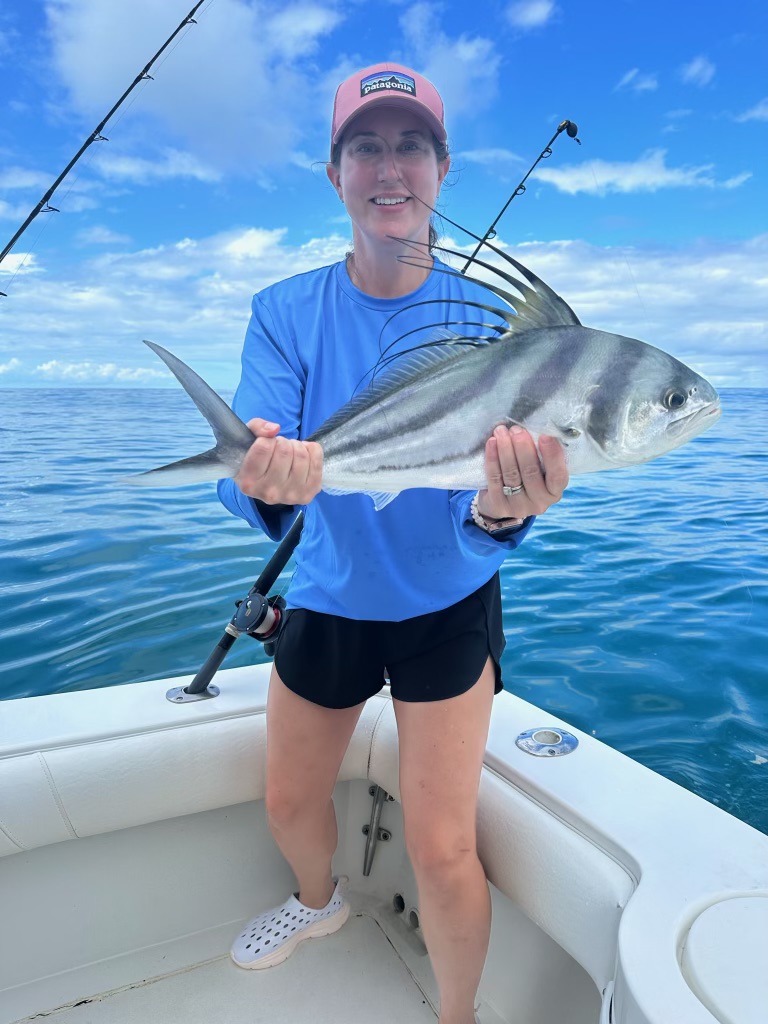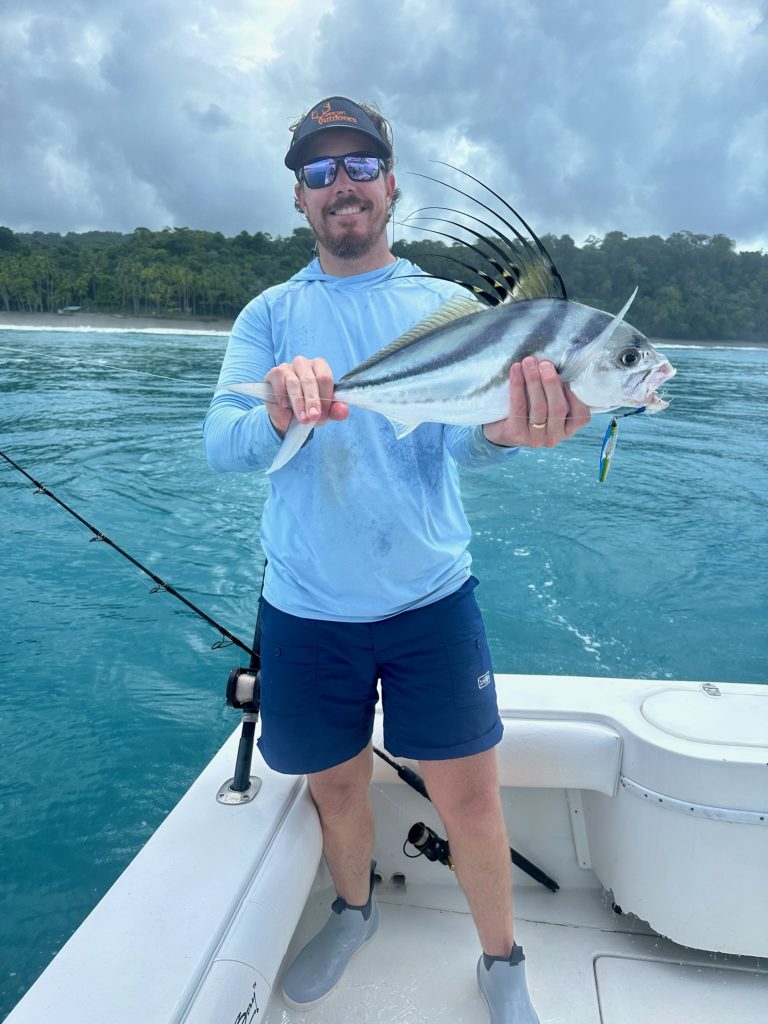Rooster Fishing Costa Rica – The Complete Guide
Costa Rica is home to some of the world’s best fishing spots, and Roosterfishing is a popular draw for many anglers. Roosterfish are known for their speed and strength, making them an exciting catch that is on the bucket list for many anglers. In this guide, we will cover everything you need to know to go Rooster fishing in Costa Rica, the equipment you will need, and the top fishing spots to try. Let’s dive in!
How Big Do Roosterfish Get?
Roosterfish are known for their impressive size and fighting ability. On average, roosterfish grow to be between 20 and 60 pounds and can reach lengths of up to 4 feet. It’s not uncommon for some individuals to reach weights of up to 100 pounds or more. The IGFA world record for the largest roosterfish ever caught is 114 pounds and was caught by angler Abe Sackheim in La Paz, Baja California, Mexico.
Where To Catch Roosterfish In Costa Rica
Roosterfish are typically found inshore and nearshore and close to rocky areas, where they feed on a variety of prey like fish, crustaceans, and squid. They are often caught using live bait such as sardines or blue runners, or with lures that imitate their natural prey such as vertical jigs. Costa Rica is known as one of the best destinations in the world for Rooster fishing, with the Pacific coast offering numerous locations to target these prized game fish. We recently sat down with Diego Camacho from Crocodile Bay Resort, located on the OSA Peninsula, to discuss the rooster fishing in Costa Rica.

Costa Rica Roosterfish Season
The peak season for catching truly large Roosterfish is generally during the transition months. “Talking to most of the captains here who have been with the company for as much as 13 years and in seven years of studying the different seasons personally, I’ve noticed that transition months from the dry season to the wet season is when we start seeing Roosterfish over 40-50 pounds,” Diego said. That being said, rooster fishing in Costa Rica is a year-round activity. If you want to keep up with what’s going on year-round, a great option is to stay on top of a local fishing report, like the one produced by Crocodile Bay, where they detail the bite for all species, including Roosterfish, 12 months out of the year.
How To Catch Roosterfish
When asked what the typical techniques are for targeting Roosterfish, Diego explained what a general strategy looks like. “What we do is drift live baits off the stern while we either cast off the bow with jigs and poppers. They love poppers, anything that makes a splash, and we’re not necessarily trying to get them on the poppers. We’re just trying to get them to come to the boat and bump into our baits in the back. Jigs are really big here as well. Not only for Roosterfish, there are so many different species you can target with jigs, which is one of my favorite methods. That’s a lot of fun.”
Best Lures For Roosterfish
As mentioned, it is important to have some poppers and vertical jigs ready for action when targeting Roosterfish. Matching your jig weight to the water depth is important, as well as the size of the Roosterfish in the area is important. Choose too large of a jig and you’ll wear yourself out and miss strikes from smaller, but still fun to catch roosters that are in the area. I found that an erratic, fast pitch back to the boat was more enticing for roosters than a slow pitch. Think like a squid darting away from a predator and your strike ratio will likely increase. Be sure to mix it up if you aren’t getting the bite.

Best Bait For Roosterfish
On my trip to Crocodile Bay, it was common to spend the first part of each trip acquiring a plethora of live baits. A couple of drops with Sabiki rigs was all we needed to brim the livewell with goggle eyes, blue runners, and sardines. “What makes it really cool to fish for Roosterfish in this area is that we have so many different methods for them. I’ve been fishing quite a few places in the world and I’ve never seen an area with so many different types of baits. If they’re not biting with the goggle eyes, we can move on to the blue runners and find something there. Eventually, we will get them to eat.” Diego says.
Rigging For Roosterfish
Rigging for Roosterfish is largely a factor of where you are fishing for them. Are you around structure targeting giants and needing to keep them out of the rocks? Or are you fishing off the structure in an area with a lot of smaller fish? Tackle up accordingly with line and leader that will match the task. Match your hook size for Roosterfish to the bait you are using, larger hardtails are going to need a larger hook than smaller sardines and the like. When it comes to a rod and reel, both spinning and casting/conventional style reels will work, but make sure you choose a rod with a lot of backbone as these fish are known for their ability to keep the fight coming for long periods. Something like a 7-foot medium/heavy spinning rod with 80 pound braided line and leader will serve you well in both drifting live bait and dropping jigs.
Rooster Fishing Costa Rica Charter Details To Consider
In general, Roosterfish tend to be more active in the early morning and late afternoon, so bookending a multi-species fishing trip by targeting Roosterfish is a very good strategy. While Costa Rica is known for its Roosterfishing, there are also a plethora of other species such as Black, Blue, and Striped Marlin, Sailfish, Mahi, Yellowfin Tuna, and Wahoo that can be targeted within a short distance from shore. If you want to stay close to shore, there are even more bucket list species that frequent the nearshore waters. A multitude of snappers, jacks, African Pompano, and other reef species all lay ready and willing to take live baits and slowpitch jigs. With the right strategy, there is a ton of action to be had.
When choosing a Costa Rica roosterfish charter, it’s important to consider a few key points to ensure a safe and successful fishing trip.
- Experience and Reputation: Look for a charter company that has experienced captains and guides who are knowledgeable about the local waters and fish species. Read reviews and ask for recommendations from other anglers to find a reputable charter company.
- Boat and Equipment: Make sure the charter company has well-maintained boats and high-quality fishing equipment, including a variety of rods, reels, and lures. The boat should also have safety equipment such as life jackets and first aid kits.
- Fishing Techniques: Different charter companies may use different fishing techniques, so make sure the company you choose uses techniques that you are comfortable with and have experience using. If you want to be the angler making the cast and setting the hook, make sure to ask your charter company if they allow you to do that, as many only want you to reel in the fish, which isn’t nearly as much fun!
- Price and Services: Compare prices and services offered by different charter companies to find one that fits your budget and needs. Some charters may include transportation, food, and drinks, while others may charge extra for these services.
- Sustainable Practices: Choose a charter company that practices sustainable fishing techniques to protect the local fish populations and preserve the environment for future generations.
- Weather and Season: Check the weather and season in the area before booking a charter to ensure that the conditions are suitable for fishing and that the species you want to target are in season.
- If you want to keep fish, make sure your charter captain understands your goals for dining on fresh fish or shipping your catch home.
By considering these points, you can choose a reputable and experienced charter company that will provide you with a safe and successful Roosterfishing trip in Costa Rica.

Final Thoughts On Rooster Fishing Costa Rica
With its warm waters, rocky coastlines, and abundant marine life, Costa Rica offers some of the best opportunities in the world for catching Roosterfish. Choosing a reputable and experienced charter company is also important to ensure a safe and successful fishing trip. Done correctly, Rooster fishing in Costa Rica can be an unforgettable experience.
Full Disclosure: This post may include affiliate links. There’s no extra charge to our readers for using these.
